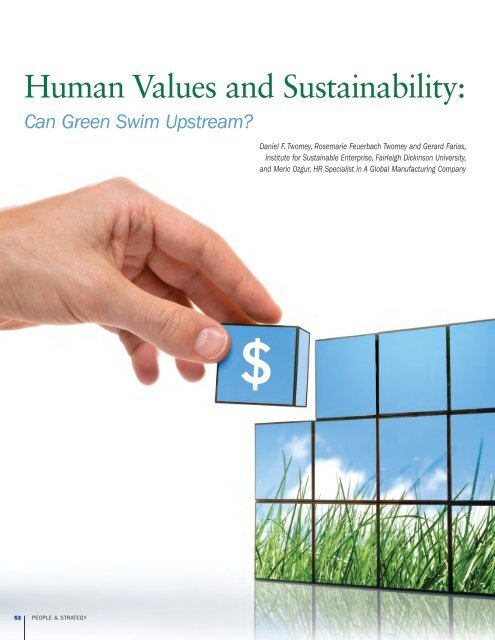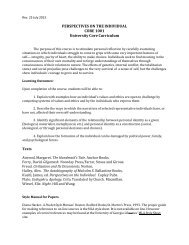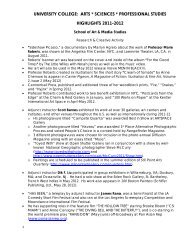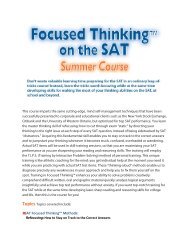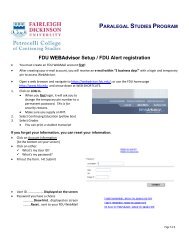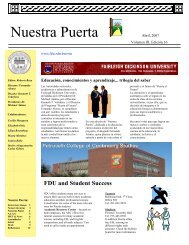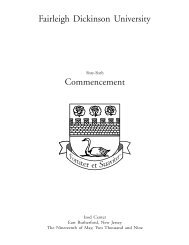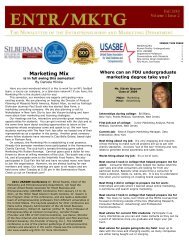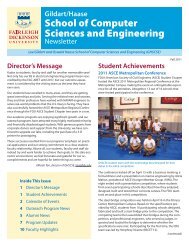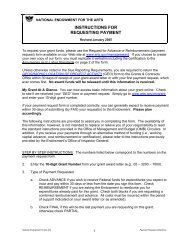Can Green Swim Upstream? - FDU
Can Green Swim Upstream? - FDU
Can Green Swim Upstream? - FDU
You also want an ePaper? Increase the reach of your titles
YUMPU automatically turns print PDFs into web optimized ePapers that Google loves.
Human Values and Sustainability:<br />
<strong>Can</strong> <strong>Green</strong> <strong>Swim</strong> <strong>Upstream</strong>?<br />
52 PEOPLE & STRATEGY<br />
$<br />
Daniel F. Twomey, Rosemarie Feuerbach Twomey and Gerard Farias,<br />
Institute for Sustainable Enterprise, Fairleigh Dickinson University,<br />
and Meric Ozgur, HR Specialist in A Global Manufacturing Company
A human value is the “desirable” that influences the selection of our actions (Williams, 2000).<br />
“Values-in-use”—are those values that actually influence our decisions and actions, as opposed<br />
to values that are “espoused” but do not influence choices of action (Argyris & Schön, 1996).<br />
We focus on those human values that lead to decisions and actions that influence sustainability.<br />
Changing Values<br />
Changes in values-in-use can be seen in our<br />
schools, businesses and all levels of government.<br />
For example, a value-in-use that has<br />
changed over time is evident in the statement,<br />
“Cheating is okay if you don’t get caught”<br />
(Whitley, 1998). This “desirable” is self-serving<br />
and displaces the old “desirable” value of<br />
integrity.<br />
Historically, we as a nation make claim to<br />
specific human values, such as honesty, hard<br />
work and the Golden Rule. Also, our nation<br />
embraces democracy and democratic principles.<br />
Today’s businesses, universities,<br />
governments and religious congregations<br />
proclaim adherence to these historic values.<br />
Yet, these values are no longer dominant in<br />
many institutions. They may be espoused,<br />
but they do not influence behaviors, as evidenced<br />
by the recent spate of scandals in<br />
corporate and public life. Instead, a new set<br />
of values-in-use has been gaining strength,<br />
and is now embedded in many parts of our<br />
society, especially business. We believe these<br />
values will hinder efforts toward sustainability.<br />
Such values and their consequences are<br />
readily seen in some major corporations.<br />
And, because of the dominance of business in<br />
society, the role it plays in re-establishing sustaining<br />
values may determine the fate of<br />
human civilization (Speth, 2008).<br />
Sustainability: Reversing<br />
Underlying Forces<br />
Sustainability has come to mean many different<br />
things and has, in part, become<br />
synonymous with the term, “green.” To the<br />
extent that “green” focuses primarily on the<br />
natural environment and on short-term<br />
efforts, it falls short of addressing the larger<br />
scope of sustainability concerns. “Sustainability,”<br />
as we use it, is captured in the more<br />
holistic, longer-term perspective of the<br />
Brundtland Commission Report in which<br />
sustainable development “meets the needs of<br />
the present without compromising the ability<br />
of future generations to meet their own<br />
needs” (Report of the Brundtland Commission,<br />
1987). Sustainability takes into account<br />
societal, as well as environmental issues, and<br />
views these as highly interdependent.<br />
Many experts claim the time is fast approaching<br />
when downward trends in the planet’s<br />
life-support systems will accelerate, and<br />
reversal will no longer be possible (Hawken,<br />
2007; Stern, 2008). Contemporary business<br />
and society foster values like growth and consumption<br />
that tend to run counter to<br />
community values (Speth, 2008). This, in<br />
turn, prompts actions that degrade life-support<br />
systems. Such values-in-use, like growth<br />
and consumption, enable and reinforce the<br />
perceptions, beliefs and actions that seep into<br />
the structures, procedures and systems of<br />
organizations. Woven into their fabric, they<br />
become self-justifying and resistant to change.<br />
Outcomes of these values-in-use include<br />
autocratic hierarchy, extraordinary differences<br />
in pay, limited transparency, deceitful<br />
practices and short-term profits as the major<br />
objective, and limited regard for society and<br />
the environment. Toyota CEO’s recent admission<br />
to Congress that the company shifted its<br />
emphasis away from safety to favor growth<br />
exemplifies this. The sustainability problem<br />
is systemic, so corrective actions must address<br />
the whole system, including its fundamental<br />
driver—human values (Horkheimer, 1941).<br />
Just as bad money drives out good money,<br />
bad values drive out good values. Ghoshal<br />
(2005) points out how academic theories<br />
built on a set of negative values, like focusing<br />
on shareholder value at the exclusion of other<br />
things, form the foundation for business<br />
practices and become self-fulfilling prophesies.<br />
Indeed, Harris (2009) found that while<br />
the application of agency theory was intend-<br />
ed to align the interests of shareholders and<br />
managers, the evidence indicated the opposite.<br />
Similarly, Leavitt (1989), Handy (2002),<br />
Marshall (2004) and Mitroff (2004) all have<br />
expressed deep concern over the loss of vision<br />
and values in business education.<br />
Some organization leaders understand the<br />
need for substantial change and are “going<br />
green.” They have taken significant actions<br />
to better serve society and to limit damage to<br />
the environment. However, the depth, scope<br />
and urgency of the sustainability challenge<br />
will require a greater response—not only in<br />
time and effort, but also in creativity, innovation<br />
and fundamental changes in lifestyles<br />
and existing practices.<br />
For instance, Ray Anderson, founder of Interface<br />
Carpet, made a commitment to make the<br />
company carbon neutral by the year 2020.<br />
The people at Interface welcomed the challenge.<br />
The company reports significant<br />
environmental improvements and substantial<br />
cost savings. We believe these results have<br />
been generated because of the human value<br />
of caring for others, the environment and the<br />
future. We doubt that others can meet the<br />
challenge without embracing values that provide<br />
the context that enables actions to<br />
emerge that align with sustainability.<br />
<strong>Swim</strong>ming <strong>Upstream</strong><br />
Many green initiatives, prompted by external<br />
pressures to consider the triple-bottom line of<br />
people, planet and profits, increase efficiency<br />
and/or reduce waste, thereby providing creative<br />
ways to increase profits. These green<br />
initiatives are consistent with current values<br />
and require no fundamental change in valuesin-use—they<br />
are “swimming downstream”<br />
green initiatives. Wal-mart’s cost-saving sustainability<br />
initiatives, like saving energy, are<br />
easy to implement because they align with<br />
company values and culture—“swimming<br />
downstream.”<br />
➤<br />
VOLUME 33/ISSUE 1 — 2010 53
The problem is that doing what is consistent<br />
with contemporary values-in-use will not<br />
bring about the fundamental changes needed<br />
to fully address sustainability issues. Much<br />
more difficult to undertake or maintain are<br />
initiatives that conflict with corporate values—<br />
that “swim upstream.” Ray Anderson<br />
(1998) refers to “climbing sustainability<br />
mountain,” implying that “going green” gets<br />
steeper and harder.<br />
54 PEOPLE & STRATEGY<br />
(Twomey, 2006; Leiserowitz, Kates, and Parris,<br />
2006); and pretence of knowledge (Hayek,<br />
1989, Ghoshal, 2005).<br />
Individualism and Hedonism<br />
Individualism, which can be a desirable trait<br />
when the situation demands it (the rugged<br />
individualism of pioneers), has become large-<br />
Contemporary values-in-use will not bring about the<br />
fundamental changes needed to fully address<br />
sustainability issues.<br />
HR is no stranger to swimming upstream.<br />
Long-term development programs that conflict<br />
with short-term financial goals are<br />
sometimes swept away when, for example,<br />
HR may be encouraged to increase shortterm<br />
profitability by outsourcing special skill<br />
needs and downsizing, rather than developing<br />
current employees.<br />
NON-SUSTAINING<br />
VALUES AND THEIR<br />
CONSEQUENCES<br />
Non-sustaining human values are those<br />
“desirables” that are not aligned with sustainability—the<br />
well being of people and<br />
planet, present and future. Sometimes nonsustaining<br />
values are extreme or perverted<br />
forms of historically desirable values. For<br />
example, personal well being, when balanced<br />
with the well being of others, reflects the<br />
value of equity. However, when personal well<br />
being disregards others, the value can transform<br />
into greed. When disregard for the<br />
“other” is manifested at the corporate level,<br />
it can negatively affect the climate, water and<br />
air quality—earth’s life-support systems.<br />
Greed is, therefore, a non-sustaining value.<br />
While there is limited research on the role of<br />
human values and sustainable development,<br />
“most advocates for sustainable development<br />
recognize that for it to be realized would<br />
require changes in human values” (Leiserowitz,<br />
Kates, and Parris, 2006, 441). The three<br />
value sets that follow are frequently cited as<br />
contributing directly or indirectly to problems<br />
that make sustainability more difficult<br />
to achieve: individualism and hedonism<br />
(Etzioni, 2002); non-democratic values<br />
ly a non-sustaining value, as in “What’s in it<br />
for me?” When individualism rises to the level<br />
of dominance, it threatens such human values<br />
as equity, mutuality and community. Individualism<br />
is evidenced in the workplace when<br />
behaviors are externally motivated and controlled<br />
through a system of personal rewards.<br />
These reward strategies are justified by claims<br />
of increased productivity and profits. Yet,<br />
much of the literature suggests the opposite,<br />
especially when it involves creativity, initiative<br />
and/or cooperation (Argyris & Schön,<br />
1996). Singh and Krishnan (2008) report that<br />
they found positive relationships between<br />
self-sacrifice, altruism and transformational<br />
leadership, which, in turn, is related to collective<br />
identity and perceived unit performance.<br />
Similarly, the pursuit of happiness is a fundamental<br />
human right, but taken to the extreme,<br />
it can be a non-sustaining value that does not<br />
align with sustainable choices and actions.<br />
Advertisers spend millions developing ads<br />
that entice customers to buy, whether or not<br />
the goods or services are actually good for the<br />
customer. For example, in response to a<br />
recent ban on chocolate milk in a school cafeteria<br />
because of high sugar content, the milk<br />
industry launched a campaign to encourage<br />
its consumption, arguing that chocolate milk<br />
is better than no milk (Brady, 2009.) So, what<br />
is really being sold? We suggest that it is<br />
mostly pleasure or privilege—intangibles<br />
associated with feeling good and fostering the<br />
value of hedonism.<br />
When individualism and hedonism predominate<br />
in a society, the resulting attitude can be,<br />
“What is the least I can do to get what I<br />
want?” This combination of values directly<br />
runs counter to those needed to effect a sus-<br />
tainable society, including equity, community,<br />
generosity, trust and the desire to make a<br />
contribution.<br />
Non-democratic Values<br />
Democratic principles constitute a set of<br />
human values shared by citizens of the United<br />
States and other countries throughout the<br />
world. Democracies are, ideally and by their<br />
nature, “of the people, by the people and for<br />
the people.” People, not their leaders, have the<br />
ultimate say. The peoples’ influence is exercised<br />
through choice, and that choice is most<br />
effective when it is exercised in a free,<br />
informed and uncorrupted forum.<br />
Many large U.S. corporations operate in a<br />
manner inconsistent with democratic principles<br />
and the values that ensure an effective<br />
democracy (Twomey, 2006). Handy (2002),<br />
ranked second in 2001 among the most influential<br />
living management thinkers by<br />
Thinkers 50, wrote, “It is ironic that those<br />
countries that boast most stridently about<br />
their democratic principles derive their<br />
wealth from institutions that are defiantly<br />
undemocratic, in which all serious power is<br />
held by outsiders and power inside is wielded<br />
by a dictatorship or, at best, an oligarchy.”<br />
For many organizations, their employees,<br />
supply chains, consumers and the communities<br />
impacted by them have little or no voice<br />
in decision making. Over time, corporate values<br />
have replaced traditional human values<br />
throughout society—particularly monetary<br />
gain over well-being of people and planet<br />
(Speth, 2008). Sharon Beder (2008), a noted<br />
educator and author, stated, “[T]he market<br />
values of competition, salesmanship and<br />
deception have replaced the democratic ideals<br />
of truth and justice.” Likewise, in<br />
discussing the impact of today’s corporations,<br />
Fotopoulos (2008) observed,<br />
“Increasingly, there is little room for the<br />
expression of higher human values and qualities<br />
such as generosity, compassion,<br />
selflessness, willingness to seek out and<br />
expose the truth, and courage to fight for<br />
justice.”<br />
Knowing and Certainty (Pretence<br />
of Knowledge)<br />
Being perceived as knowing and being right<br />
has increasingly become desirable in our society<br />
and organizations (Yanow, 2009.) In<br />
contrast, humility and a willingness to learn<br />
opens minds to the influence of others and<br />
new ideas. For example, it is the non-sustain-
ing value of certainty that leads some to deny<br />
global warming outright, in the face of substantial<br />
evidence to the contrary. Conversely,<br />
some promote global warming and deliberately<br />
limit debate on the topic. This desire to<br />
be right and not be challenged, which occurs<br />
at all levels, not only makes for bad decisions<br />
but also makes change nearly impossible.<br />
Leaders who “know with unquestioned certainty”<br />
operate within fixed ideas and goals,<br />
and are unlikely to collaborate with others or<br />
explore the complexity and dynamics of<br />
larger systems (Sharma, 2000; Boiral, Cayer,<br />
& Baron, 2009). Incorporating sustaining<br />
values into corporate strategies and processes<br />
will require systemic and paradigm-shifting<br />
change.<br />
SUSTAINABILITY<br />
PATH: What HR<br />
<strong>Can</strong> Do<br />
The sustainability path refers to going beyond<br />
what is typically perceived as “green.” Popular<br />
green initiatives, while noteworthy and<br />
necessary, are not enough to transform the<br />
company to be fully sustainable. An examination<br />
of the current values-in-use can begin a<br />
shift in both operations and processes as a<br />
first step on the path to sustainability.<br />
What is the path to aligning business with<br />
sustaining human values? A good place to<br />
start is the Stockdale Paradox (Collins, 2001)<br />
that contains two sustaining qualities, integrity<br />
and trust. Stockdale’s principle was,<br />
“Face the brutal facts, and keep faith in a<br />
positive outcome.”<br />
First, face the brutal facts: (A) Consumers<br />
and the public are right in their dismal assessment<br />
of corporations and leaders (Edelmans<br />
Trust Barometer 2010 reports recent tenuous<br />
rises after recording 10-year lows); and<br />
(B) Corporations have played a key role in<br />
weaving the fabric of non-sustaining human<br />
values into society (Speth, 2008). Second,<br />
keep the faith: (A) We need to believe in a<br />
sustainable future and act to transform ourselves<br />
and our organizations for the purpose<br />
of preserving planet and people; and (B) Make<br />
this our passion and, along with others,<br />
inquire about and build a new paradigm for<br />
the corporation and society—one that incorporates<br />
human values that are aligned with<br />
sustainability (Hamel, 2009).<br />
HR: Create a Dialogue<br />
Because engagement of people is fundamental<br />
to transformational efforts, HR is<br />
perfectly poised to support the organization<br />
as the custodian of human values. To initiate<br />
a dialogue about the transformation of values-in-use<br />
for the purpose of attaining<br />
sustainability objectives, HR can take the following<br />
steps. First, HR can start an internal<br />
assessment of its own values-in-use using a<br />
ExHIBIT 1: HR NON-SUSTAINING PRACTICES VS. SUSTAINING PRACTICES<br />
Non-sustaining practices Sustaining practices<br />
dichotomy of HR practices (See Chart 1).<br />
Second, HR can embed the dialogue about<br />
values and sustainability into traditional HR<br />
functions such as recruitment, hiring and<br />
training. Third, in partnership with the organization’s<br />
other executives and managers,<br />
HR can extend the dialogue throughout the<br />
entire organization. By shining a light on the<br />
gaps between the espoused values and valuesin-use,<br />
the stage is set to bring about greater<br />
alignment.<br />
1. A Beginning<br />
A major vehicle and context for promoting<br />
the sustaining values is community. As Block<br />
(2008) indicates, community is the place<br />
where the level of trust, connectedness and<br />
common purpose allows us to name and let<br />
go of the past to create a different future. As<br />
a beginning, HR can strengthen its own community<br />
around the common purpose of<br />
creating greater value for the firm and society<br />
by examining and shifting values-in-use. The<br />
HR unit could use items in Chart 1 to name<br />
(acknowledge) non-sustaining values-in-use<br />
and develop possibilities for new values.<br />
Throughout this process, HR must learn how<br />
to create a context for itself and others that<br />
will foster a paradigm-shifting dialogue.<br />
Chart 1 distinguishes between two sets of<br />
practices—non-sustaining and sustaining—<br />
and provides an effective way to differentiate<br />
and examine values-in-use. By moving to the<br />
sustaining practices, and changing values-in-<br />
Hire talent when you need it workforce Develop talent to create opportunities<br />
Claim values but don’t examine espoused values vs. values-in-use Surface and develop: top to bottom<br />
Top down: direct and control organizing principle Organic: Self directed and managed<br />
Incremental within current paradigm change Radical: Deep and transformational<br />
Prescribed and limited (silos) career paths Self-generated and broad<br />
Growth, technology, money drivers Values, people, society<br />
Top-down – individually based decision making/action Collaborative – co-creation based<br />
Based on financial outcomes rewards Based on financial and non-financial outcomes<br />
Internal, process focused impact Internal and external, strategy focused<br />
Limited to business responsibility To all stakeholders<br />
➤<br />
VOLUME 33/ISSUE 1 — 2010 55
use, HR will be laying the foundation for a<br />
larger organizational transformation.<br />
Any group within or outside the firm might<br />
notice and explore how the practices on each<br />
side of the chart are interactive and reinforcing.<br />
Reflecting on those practices and how<br />
they change over time can provide additional<br />
insight. HR professionals, in collaboration<br />
with other units, can customize the chart for<br />
the various functions and levels of the firm<br />
and use it as a basis for a dialogue about the<br />
larger fabric of the organization.<br />
2. Branching Out<br />
Any level in an organization can shift values<br />
by deliberately (1) raising awareness of the<br />
sustainability challenges, (2) surfacing personal<br />
values-in-use versus the corporate/<br />
organizational values-in-use as they relate to<br />
sustainability, (3) enabling a commitment to<br />
change, and (4) aligning practices with sustaining<br />
values. Identifying non-sustaining<br />
1. Do our values-in-use in the corporation/organization<br />
enable a high level<br />
of creativity, innovation, adaptability<br />
and internal motivation throughout<br />
the organization? What current values-in-use<br />
limit or promote these<br />
behaviors?<br />
2. What are the values-in-use with<br />
respect to top management, hierarchy<br />
and control, rewards and punishments<br />
in the corporation/organization? What<br />
is the impact of those values and<br />
resultant practices on our unit?<br />
3. What are the values-in-use in our<br />
unit? How are they integrated? Are<br />
they acknowledged?<br />
4. Do we operate in an environment of<br />
transparency where information is<br />
openly shared? What are the valuesin-use<br />
that encourage or discourage<br />
transparency?<br />
5. What are my/our personal/family/<br />
community values-in-use?<br />
6. How are my/our values-in-use different<br />
from corporate/organizational<br />
values-in-use?<br />
56 PEOPLE & STRATEGY<br />
values is difficult because they exist not only<br />
at the personal level but also within the fabric<br />
of the organization—in its processes, structures<br />
and reward systems. Hamel (2009)<br />
gives 25 examples of ways to change the fabric<br />
of the firm to transform its ability to meet<br />
the challenges facing the world.<br />
HR’s greatest contribution to the organization<br />
and to the organization’s stakeholders<br />
may be to create a dialogue that will shed<br />
light on the corporation’s values-in-use and<br />
thereby leverage change. The positive, sustainable<br />
values the firm claims are often<br />
espoused values—not its values-in-use. Closing<br />
the gap between sustainable and<br />
non-sustainable values needs to be approached<br />
in a way that allows change to emerge rather<br />
than be forced. A first step is to help people<br />
to see the gap and its consequences for behaviors<br />
related to sustainability, such as<br />
innovation, creativity and motivation. A next<br />
step is to tap the knowledge of the organiza-<br />
$<br />
tion to better understand the systemic nature<br />
of the gap. A cross-organizational dialogue<br />
will highlight the gaps and open possibilities<br />
for aligning values (and thereby practice and<br />
behavior) with sustainability. The process<br />
through which the firm achieves this will be<br />
unique to each situation, as it relates to the<br />
current challenges the company faces. Typical<br />
HR avenues for building a dialogue include<br />
employment decisions, performance appraisal,<br />
training/development, reward and<br />
recognition processes, work/life balance<br />
practices, employee surveys and companywide<br />
events. Through such activities, HR<br />
can initiate a series of dialogues among<br />
employees by asking some focused, exploratory<br />
questions.<br />
Based on the responses to these questions and<br />
on the values to which the organization is<br />
committed, HR can seek ways to embed the<br />
desired values into HR processes. For example,<br />
reexamine recruitment materials,
ExHIBIT 2: VALUES-IN-USE AND TRUST BETWEEN BUSINESS AND ITS STAKEHOLDERS<br />
TRUST<br />
reconsider where recruitment takes place and<br />
ask whether the questions asked of candidates<br />
might be changed to better reflect the<br />
values needed to advance the sustainability of<br />
the organization, its people and the greater<br />
community, and so on. These efforts can be<br />
part of a continuous cycle of inquiry and<br />
learning.<br />
3. Engaging the Organization in<br />
Transformation<br />
A third step, beyond the HR unit and HR’s<br />
major roles, is to engage the entire organization<br />
as a partner in transformation. A likely<br />
first partner is the unit most responsible for<br />
sustainability. As in the other steps, the action<br />
is co-created from the possibilities that<br />
emerge from a broad-based dialogue between<br />
units. Now the focus shifts to the organization<br />
level and its strategy and operations.<br />
The following activities might be helpful in a<br />
dialogue. These items are not steps, but rather<br />
they offer places to start a dialogue. Most<br />
important is the trust, openness and commitment<br />
that enable people to have the courage<br />
to surface and share their values, assumptions<br />
and beliefs. This is not about HR creating<br />
solutions or programs for others. This is<br />
Business<br />
Alignment<br />
Value-in-use<br />
Possible Corresponding Action<br />
Honesty . . . . . . . . . . . . . . . . . . . . . . . . . . . . . . . . . . Accurate information �ow<br />
Freedom . . . . . . . . . . . . . . . . . . . . . . . . . . . . . . . . . Innovation<br />
Equity . . . . . . . . . . . . . . . . . . . . . . . . . . . . . . . . . . . . Collaboration<br />
Mutuality . . . . . . . . . . . . . . . . . . . . . . . . . . . . . . . . . Co-creating common ground<br />
Stakeholders<br />
people taking responsibility for their valuesin-use<br />
and the behaviors they prompt.<br />
1. Raise awareness of the current values-in-use<br />
Inquire. What are customers, employees, and<br />
the public telling us and other corporations<br />
like us about our role in society and the<br />
world? What are the values that have contributed<br />
to the non-sustainable behaviors and<br />
outcomes of the firm? Where are the gaps?<br />
What values-in-use do the gaps reflect?<br />
2. Acknowledge the current values-in-use<br />
and their negative consequences.<br />
Create an internal dialogue across the organization<br />
about how customers, employees<br />
and the public view the business. Surface the<br />
values-in-use that underlie the positive or<br />
negative actions/feedback. In particular, surface<br />
those values-in-use that block the firm<br />
from moving forcefully toward sustainability.<br />
3. Develop a new set of core values-in-use<br />
Together, make a list of sustaining values-inuse<br />
that might prompt innovative, trusting<br />
and transparent behaviors and outcomes for<br />
the customers, employees and the public, as<br />
well as for the firm. Possibly, start with the<br />
values-in-use that drive one’s own passion.<br />
TRUST<br />
4. Compare the new set with corporate values<br />
In an honest assessment, most firms will find<br />
major gaps between their corporation’s<br />
claimed values and their current values-inuse.<br />
Surface and acknowledge the gaps and<br />
show how current values-in-use are part of<br />
the fabric of the firm, affecting its external<br />
relationships, its strategies and its HR practices.<br />
Also, individuals must take personal<br />
responsibility for being actively or passively<br />
part of this fabric. Explore the fabric—for<br />
example, language, processes and structures.<br />
5. Align HR practices and values-in-use<br />
Together, develop a strategy driven by those<br />
values-in-use that are the new core of the<br />
firm. The change in values-in-use will substantially<br />
change, as well as strengthen, the<br />
strategy formulation process.<br />
Using “Trust” to Demonstrate How<br />
HR <strong>Can</strong> Begin a Transformation<br />
A key characteristic of “best companies” is<br />
the establishment and maintenance of trust<br />
between an organization and all its stakeholders,<br />
particularly in the context of<br />
organizational transformation (Collins,<br />
2001).<br />
➤<br />
VOLUME 33/ISSUE 1 — 2010 57
Trust, a positive expectation of intent and<br />
outcomes, is reinforced and becomes a virtuous<br />
cycle when expectations are met<br />
consistently. The Diagram that follows illustrates<br />
the cycle. A business establishes trust<br />
by its values-in-use, such as honesty, freedom,<br />
equity and mutuality (sustaining values)<br />
manifested in the behaviors that those values<br />
prompt. For example, honesty might prompt<br />
the corresponding action of “accurate information<br />
flow.”<br />
When a corporation has non-sustaining values-in-use,<br />
such as individualism,<br />
non-democratic principles and certainty,<br />
negative behaviors and outcomes can lead to<br />
a vicious, downward cycle. When a corporation<br />
“espouses” sustaining values while<br />
acting on non-sustaining values-in-use, cynicism<br />
results and trust is eroded.<br />
For employees and other stakeholders to<br />
trust a company, a company needs a longterm<br />
commitment to the alignment of its<br />
actions with stated sustaining values. (See<br />
Diagram 1) A deep long-term dialogue is<br />
facilitated by a shared mutual intent that is<br />
more than the company’s need for profit,<br />
such as transforming the company’s role<br />
in society.<br />
Conclusion<br />
Every organization must find its own way<br />
forward as it faces a highly dynamic and competitive<br />
marketplace. Putting human values<br />
into the conversation is a means of distinguishing<br />
the level and types of change to<br />
pursue and how current values are supporting<br />
or limiting objectives. Comparing the<br />
“business case” with the “sustainability case”<br />
provides alternative perspectives on the type<br />
and level of change desired. The business case<br />
is usually about incremental change—change<br />
within the current processes and authority<br />
structure—with a primary focus on the financial<br />
impact. The sustainability case is about<br />
benefitting society and the environment,<br />
where profit is more of a means to that end<br />
(Collins, 2001; Hamel, 2009).<br />
Higher levels of sustainability require transformation<br />
of major approaches and<br />
processes that are driven by a set of human<br />
values different from those pertinent to the<br />
business case. The business case assumes a<br />
high level of knowing, first by those who propose,<br />
document and provide the rationale for<br />
a project, and then by the managers who give<br />
approval. Embedded in the business case is a<br />
58 PEOPLE & STRATEGY<br />
process involving top-down direction and<br />
control consisting of a set of procedures,<br />
communications, job descriptions and<br />
appraisal and reward systems. The business<br />
case is well-suited for incremental change and<br />
fits well with dominant current values.<br />
The “sustainability case” is a different paradigm<br />
for business—one that supplants the<br />
“business case.” The sustainability case, in<br />
which societal and environmental concerns<br />
play a pivotal role, is about collaboration,<br />
openness to emergence, self-organizing, community<br />
building, internal motivation and a<br />
robust systems perspective (Twomey, 2006).<br />
It is less about knowing, certainty, hierarchy,<br />
reward-driven behaviors, individual welldefined<br />
responsibilities and short timeframes<br />
(Twomey, 2006). The sustainability case is<br />
aligned more with creating a long-term sustainable<br />
future. Moreover, it provides the<br />
means for the transformation needed to make<br />
this possible.<br />
References<br />
Anderson, R. (1998). Mid-Course Correction. Peregrinzilla<br />
Press.<br />
Argyris, C. & Schön, D. A. (1996). Organization learning<br />
II: theory, method, and practice. Reading, MA: Addison-<br />
Wesley.<br />
Beder, S. (2008). The corporate assault on democracy. The<br />
International Journal of Inclusive Democracy, 4(1).<br />
Block, P. (2008) Community: The structure of belonging.<br />
San Francisco: Berrett-Koehler.<br />
Boiral, O, Cayer, M., and Baron, C.M. (2009). The action<br />
logics of environmental leadership: A developmental perspective.<br />
Journal of Business Ethics, 85, 479-499.<br />
Brady, J. (2009, December) Dairy groups fight to keep<br />
chocolate milk on menu. All things considered. Retrieved<br />
from http://www.npr.org/templates/story/story.<br />
php?storyId=121238407.<br />
Collins, J. (2001). Good to great. New York: Harper Collins<br />
Publishers Inc.<br />
Etzioni, A. (2002). Individualism—within history, The<br />
Hedgehog Review, Spring, 49-56.<br />
Fotopoulos, T. (2008). Values, the dominant social paradigm<br />
and neoliberal globalisation. The International<br />
Journal of Inclusive Democracy, 4(1).<br />
Gentile, M. C. (2008) The 21st century MBA.<br />
Strategy+Business, 51, 1-12.<br />
Ghoshal, S. (2005). Bad management theories are destroying<br />
good management practices. Academy of Management:<br />
Learning & Education Journal, 4 (1), 75-91.<br />
Hamel, G. (2009). Moonshots for management. Harvard<br />
Business Review, February 2009.<br />
Handy, C. (2002). What’s a business for? Harvard Business<br />
Review, December, 49-55.<br />
Harris, J. D. (2009) What’s wrong with executive compensation?<br />
Journal of Business Ethics, 85, 147–156.<br />
Hawken, P. (2007). Blessed unrest. Viking Penguin.<br />
Hayek, F. A. Von. (1989). The pretence of knowledge (Nobel<br />
Lecture). American Economic Review, December, 3-7.<br />
Horkheimer, M. (1974). Eclipse of reason. Seabury Press,<br />
(1974) (Originally 1941).<br />
Leavitt, H. G. (1989.). Educating our MBAs: On teaching<br />
what we haven’t taught. California Management Review,<br />
31 (3), 38-50.<br />
Leiserowitz, A.A., Kates, R.W., Parris, T.M. (2006). Sustainability<br />
values, attitudes, and behaviors: A review of<br />
multinational and global trends. Annual Review Environmental<br />
Resource, 413-444.<br />
Marshall, J. 2004. Matching form to content in educating<br />
for sustainability: The masters (MSc) in responsibility and<br />
business practice. In Galea, C. (Ed.), 2004. Teaching Business<br />
Sustainability, 1.Sheffield,UK: <strong>Green</strong>leaf, 196-208.<br />
Mitroff, I. (2004). An open letter to the deans and the<br />
faculties of american business schools from ABI/INFORM<br />
global. (Document ID: 724522921).<br />
Report of the Brundtland Commission (1987). Our common<br />
future. Oxford University Press.<br />
Report of Edelman’s Trust Baramoter (2010). Trust: 2010<br />
trust barometer executive summary. Retrieved from http://<br />
www.scribd.com/full/26268655?access_key=key-1ovbgbpawooot3hnsz3u<br />
Sharma, S. (2000). Managerial interpretations and organizational<br />
context as predictors of corporate choice of<br />
environmental strategy. Academy of Management Journal,<br />
43(4), 681-697.<br />
Singh, N. and Krishnan V. R. (2008). Self-sacrifice and<br />
transformational leadership: Mediating role of altruism.<br />
Leadership & Organization Development Journal, 29(3),<br />
261-274.<br />
Speth, J. G. (2008). The bridge at the edge of the world.<br />
New Haven, CT: Yale University Press,<br />
Stern, N. (2008). The economics of climate change. American<br />
Economic Review, 98(2), 1–37.<br />
Twomey, D. F., (2006). Democracy and sustainable enterprise.<br />
Global Forum, 4(1), 236-241.<br />
Twomey, D. F., 2006. Designed emergence as a path to<br />
enterprise sustainability, E+CO: Emergence: Complexity<br />
and Organization, 8(1), 12-23.<br />
Whitley, B. (1998). Factors associated with cheating<br />
among college students: A Review. Research in Higher<br />
Education, 39(3), 235-274.<br />
Williams R., (2000). Change and stability in value and<br />
value systems: A sociological perspective. In M. Rokeach<br />
(Ed.) Understanding Human Values: Individual and Societal,<br />
New York, NY: Simon-Schuster.<br />
Yanow, D. (2009). Ways of knowing: passionate humility<br />
and reflective practice in research and management.<br />
American Review of Public Administration, 39(6), 579.
Dr. Daniel F. Twomey is professor of management at Fairleigh<br />
Dickinson University (<strong>FDU</strong>). He received a Doctorate of Business<br />
Administration from Kent State University. For the past<br />
decade Twomey’s research and professional activities have<br />
focused on leadership, learning, organization design and sustainability.<br />
He is a co-founder and a director of the Institute<br />
for Sustainable Enterprises and the founder and director of<br />
the Center for Human Resource Management Studies at <strong>FDU</strong>.<br />
He organized the annual Professional Development Workshop<br />
“Practitioner Series: Action Research Community” at<br />
the Academy of Management.<br />
Rosemarie Twomey is professor of legal studies in business at<br />
Fairleigh Dickinson University (<strong>FDU</strong>) where she teaches in the<br />
Executive and regular MBA programs. She received her J.D.<br />
from West Virginia University College of Law and practiced<br />
law for 10 years before pursuing an academic career. She was<br />
a charter member of the Center for Human Resource Management<br />
Studies (CHRMS) and helped establish the Institute for<br />
Sustainable Enterprise (ISE) at <strong>FDU</strong>. Recently, McGraw-Hill<br />
published her textbook, “Employment Law: Going Beyond<br />
Compliance to Engagement and Empowerment.”<br />
Gerard Farias is associate professor of management in the<br />
Silberman College of Business at Fairleigh Dickinson University.<br />
He teaches strategic management, change management<br />
and organization theory. His interests lie in the areas of emergent<br />
organization and the role of business in society,<br />
particularly with regard to sustainability. Within these broad<br />
fields, he has focused on the role of human values, leadership<br />
and wisdom in the context of business and society.<br />
Meric Ozgur is working as a human resources specialist in a<br />
global manufacturing company where she is a practitioner in<br />
numerous HR functions, including compensation, international/domestic<br />
relocations and immigration. She received her<br />
undergraduate degree in Statistics, at Middle East Technical<br />
University, Ankara, Turkey and her EMBA degree at Fairleigh<br />
Dickinson University (<strong>FDU</strong>). She recently finished a graduate<br />
program in Managing Sustainability from <strong>FDU</strong> and INCAE<br />
Business School in Costa Rica. She is involved in several sustainability<br />
projects, focusing on individual and group<br />
behavior and its impact on business and society.<br />
Right Leaders...<br />
Ready Faster<br />
Top Global Clients Recommend<br />
PDI Ninth House*<br />
94%<br />
are willing to be a reference.<br />
84%<br />
are more satisfied with<br />
PDI Ninth House than with<br />
other talent management<br />
and HR consulting firms.<br />
* 2009 survey of PDI Ninth House global clients<br />
Premier Global Leadership Solutions Company<br />
PDI Ninth House is the premier global leadership solutions<br />
company with distinctive expertise in accelerating<br />
leadership effectiveness to maximize organizational<br />
performance. We have 43 years of experience in helping<br />
clients identify, manage, develop, and promote superior<br />
leaders across all levels of client organizations. PDI Ninth<br />
House serves thousands of clients on six continents,<br />
including 70 percent of the BusinessWeek Top 100 Global<br />
Brands, 75 percent of the Forbes Global 100, and 80<br />
percent of the Fortune 100 firms in the United States.<br />
Contact Us:<br />
1.800.633.4410 www.pdininthhouse.com<br />
PDI_NH_Ad_vert_final.indd 1 3/16/10 1:48:28 PM


